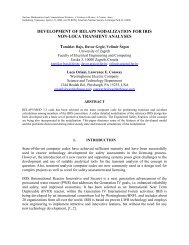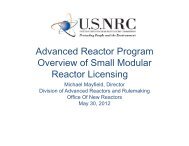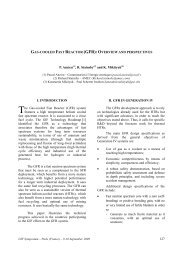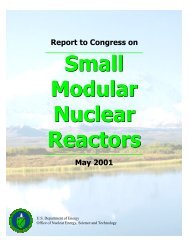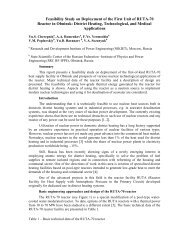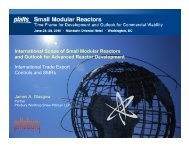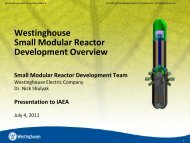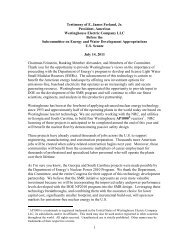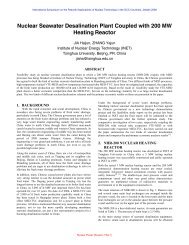Economic and Employment Impacts of Small Modular Reactors - SMR
Economic and Employment Impacts of Small Modular Reactors - SMR
Economic and Employment Impacts of Small Modular Reactors - SMR
- No tags were found...
You also want an ePaper? Increase the reach of your titles
YUMPU automatically turns print PDFs into web optimized ePapers that Google loves.
U.S. nuclear capacity projections <strong>of</strong>fered in the High scenario are extracted from the EIA Report -‐ Energy<br />
Market <strong>and</strong> <strong>Economic</strong> <strong>Impacts</strong> <strong>of</strong> H.R. 2454, the American Clean Energy <strong>and</strong> Security Act <strong>of</strong> 2009 (August<br />
2009)ase assumes<br />
low emission technologies including nuclear are developed <strong>and</strong> deployed on a large-‐scale in a timeframe<br />
consistent with CO 2 reduction requirements <strong>of</strong> the American Clean Energy <strong>and</strong> Security Act <strong>of</strong> 2009<br />
(ACESA), commonly known as Waxman-‐Markey after its legislative sponsors. In this scenario, U.S.<br />
nuclear power capacity is nearly doubled over the next 20 years with an expected net increase <strong>of</strong> 90<br />
GW. This case is also referred to as the Greenhouse Gas (GHG) Legislation case.<br />
The plot shown in Figure 1 below represents the total U.S. nuclear generating capacity by year for each<br />
<strong>of</strong> the three scenarios. Figure 2 indicates additions in generating capacity by year. This plot represents<br />
gross capacity added as plant retirements are not deducted. The zero-‐added nuclear capacity<br />
forecasted in the year 2021 for the GHG Legislation <strong>and</strong> Reference cases is from data <strong>and</strong> models<br />
supplied by EIA. The zero-‐added capacity results from scheduled expiration <strong>of</strong> the nuclear production<br />
tax credit. EPACT 2005 provided for a production tax credit <strong>of</strong> 1.8¢ per kilowatt hour <strong>of</strong> electricity<br />
produced by an advanced nuclear power facility, with a national limitation <strong>of</strong> 6,000 MW allocated to the<br />
credit. EIA conservatively assumes that the tax credit will not be renewed <strong>and</strong> builds for 2021 are solely<br />
a result <strong>of</strong> the tax credit. However, the congressional intention <strong>of</strong> the tax credit <strong>and</strong> other nuclear<br />
incentives created by EPACT 2005 was to provide assurance for new nuclear construction <strong>and</strong><br />
investment following a period where no plants had been ordered since 1978 (Holt, 2006). <br />
assumption <strong>of</strong> zero-‐added capacity in 2021 may prove to be overly conservative, it has been retained for<br />
this study so as not to alter any <strong>of</strong> the external models <strong>and</strong> datasets from EIA, IAEA, <strong>and</strong> EPRI.<br />
Nuclear Generation Capacity (Gwe)<br />
190<br />
170<br />
150<br />
130<br />
110<br />
90<br />
Figure 1<br />
Projected Domestic Nuclear Capacity (Total)<br />
Reference Case -‐ NO GHG<br />
Legislation<br />
Basic Case -‐ GHG Legislation<br />
EPRI Case<br />
2005 2010 2015 2020 2025 2030<br />
16



